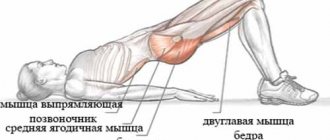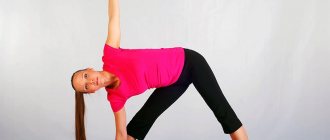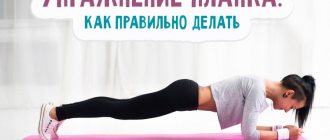Is it possible to lose weight by doing planks every day?
The plank is an isometric exercise, so it significantly influences the process of achieving an ideal figure. A comprehensive approach to solving the problem is required, because you cannot eat a lot, exercise and still lose weight. By choosing the right diet and doing cardio (running, swimming, dancing), you will be able to achieve the desired result faster.
The plank does not provide the fat burning process itself, because it creates a static load. It increases energy expenditure, which leads to greater calorie expenditure. In addition, strong abdominal back muscles will help make your stomach visually flatter. With daily exercise, you can achieve noticeable relief and weight loss. It looks much better than just a skinny person.
- Which pensioners are entitled to free trips to a sanatorium?
- Why money can be written off from a pensioner’s bank card - reasons
- 10 Reasons Why You Should Eat Saturated Fat
Exercise mode and difficulty levels
Let's look at the exercise regime - how many times a day can you do the plank and is it possible for all categories of athletes to do the plank every day?
In order to answer the question: “How long should you do the plank – every day or every other day?” , let’s decide on the difficulty levels of the exercise:
- Null. This level is for people who have little understanding of sports, who have never played sports seriously, or who have not attended physical education classes at school. They need to start their studies carefully - not to rush and not to be overzealous. The plank is recommended by experts for everyday training, but for the zero level the most gentle regimen is provided - once every other day for 10-15 seconds for 14 days.
- Elementary. They switch to it when the athlete feels able to perform the classic plank in the recommended manner. At this level, the bar should be performed daily. You need to start at 30 s. Every 3-5 days you need to increase the load time by 5 s, bringing the total time to a minute. When a person becomes able to hold the bar for 60 seconds, you need to complicate the training.
Reverse plank with straight arms
- Normal. Approaches are introduced. The first week you need to accustom your body to the appearance of approaches in training. At the first stage, the exercise time is reduced from 60 to 45 s. Rest – 60 s. After a week or earlier, if the load turned out to be acceptable, the duration of the exercise is increased to 60 s, the rest is halved. Then the duration of the exercise should be increased by 10-20 seconds every 4-7 days. When a person can hold the bar for 120 seconds, you need to reduce the rest to 15 seconds. After 3-5 days, the third approach is introduced. Again, you need to reduce the duration of the exercise to 90 s, and increase the rest time to 30 s. In this mode, the plank is done for 3-4 days, after which the duration of the exercise increases to 120 s, with the rest reduced to 15 s. The load increases every 3-5 days by 15-30 s. When a duration of 4 minutes is reached, the rest should be reduced to 8 seconds. This regime is suitable for all amateur athletes for everyday use. For those who do not want to stop there, there is an advanced level of exercise.
- Advanced. Designed for experienced athletes who know everything about the capabilities of their body. Therefore, we will not write about exercise time and approaches. The record for holding the bar is 8 hours, 1 minute and 1 second - it was set by the Chinese Mao Weidung in 2021, Beijing. The record has not been broken, but this does not mean that it cannot be broken - there are no limits to human perfection! The advanced level starts from the moment the athlete begins to practice other types of planks in addition to the classical one.
It is important to understand that the described exercise regimen is one of the training methods recommended by experts. It is the most gentle; there are other options for doing planks on the Internet.
Improving the tone of the main muscle group
The core muscles provide support for the internal organs; they also influence your posture and help protect your spine from injury and damage. If you perform the exercise every day, the corset in the abdominal area will be strengthened. The exercise involves the following main muscle groups:
- straight abdominal - when properly shaped, it is also called “cubes”;
- transverse – helps when trying to lift heavy weights;
- oblique (lateral) – responsible for the process of bending and twisting at the waist;
- buttocks - beautiful relief.
Muscles developed by the plank and its variations
What happens if you do planks every day? Of course, this question is one of the main ones that worries a person who wants to lose weight and improve their physical condition. The plank is famous for its positive effect on the abdominal muscles (abdominal muscle group) - transverse, oblique (external and internal) and rectus. But doing the plank can improve the tone of not only the abdominal muscle group, but also other important muscles responsible for stabilizing the human body in space and dynamic interaction with the world:
Muscles involved when performing the elbow plank exercise
- The core muscles, which include the abdominal group, are an important stabilizing element in the human muscular frame. Without them, serious sports activities are impossible. The core stabilizes the pelvis, hips, and spine. Frequent injuries in sports among amateurs occur precisely because of the undeveloped muscles of the core - the infraspinatus and coracobrachialis muscles, the small and medium gluteal muscles, the adductor muscles, the muscles of the back of the thigh.
- Quadratus lumborum muscle (stabilizes the pelvis during walking). In men, the developed shape of the muscle helps to walk “like a cat.” For women, the muscle allows them to smoothly swing their hips while walking.
- A group of biceps, triceps and deltoid muscles of the shoulder, pectoralis major and minor - in a developed form they make a man’s arms and chest attractive, and for women they reduce subtility in the upper part of the shoulder girdle and lift the bust.
- The serratus anterior, rhomboids, lower trapezius and erector spinae muscles will enhance your back appearance.
Muscles used when performing a side plank
Reducing the risk of back and spine injuries
The lower back receives major damage when bending over, trying to lift something heavy from the floor, or staying in a bent position for a long time. The plank is highly effective and does not create additional stress on the joints. You pump up your entire torso, including the muscles of your arms, shoulders, and legs. A strong corset helps support the spine and protect it from any damage, reducing the risk of injury.
- What mosquitoes are afraid of - a list of effective chemical and folk remedies with a description of their action
- Increased pension for parents of schoolchildren and students
- Red manicure
Correct execution of the exercise
But in the plank exercise, correct execution is extremely important. The fact is that the effectiveness of the plank and the result that a person subsequently sees in the mirror largely depends on this factor
The main thing is to know how to stand in the plank as a beginner. Of course, it is not difficult to perform, but at the same time it is important to learn how to do it once and for all, so as not to have a negative impact on various parts of the body when doing it. First of all, you need to understand what kind of plank you want to do. Beginners, those who have never performed the exercises before, stick to the classic version
This is a static plank, which is performed with emphasis on outstretched arms or forearms. This stand is the main one.
So, in order to perform the plank correctly, you need:
Lie down on a flat surface as if you are going to rest. Your hands should be at shoulder level. you need to align them so that your elbows are on the floor with your shoulders. This way you won’t have to put any strain on your neck and back when working. You need to make your legs straight and rest your toes on the floor. Heels should not be on the floor. You need to lift your torso and lower back without arching it
The body should remain straight. It is important to breathe correctly, evenly and calmly. In this position you need to fix the body and start counting
The plank strengthens your core muscles (muscles that are responsible for stabilizing the pelvis, hips and spine)
The plank is an ideal exercise for the abdominal (abdominal) muscles. After all, it uses all the key muscle groups, including the transverse, rectus, external oblique and gluteal muscles. Each of them is very important: for example, the transverse one allows you to lift weights, the straight one allows you to jump and eventually create the famous “six pack”, the oblique one allows you to side bend and “twist” the waist, the gluteal one supports your back and simply makes you look like a strong and slender person. .
♥ ON TOPIC: Why red-haired people are born and how they differ from others.
Universal exercise: Plank exercise
Table of contents
- What is the essence of such charging?
- Basic technique
- Important Notes
- Daily workouts
- Basic moments
- Exercise options Classic plank
- Side plank
- Forearm plank
- Plank with 4 point support
“Plank” is one of the most popular and effective abdominal exercises . The plank forces not only the abdominal and shoulder muscles to work, but also the muscles of the whole body. This is one of the few abdominal exercises that will allow you to get rid of lower belly fat.
What is the essence of such charging?
It consists of once a day “hovering” above the floor for several minutes, leaning only on your arms and toes.
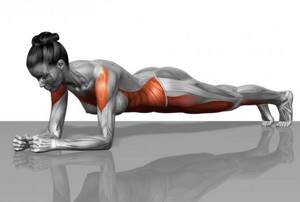
Undoubtedly, being “in limbo”, even for two minutes, is not an easy task. But the result will not keep you waiting. After just two weeks of regular exercise, you will notice how all the muscles in your body will tighten. If you do the plank “automatically” without following the technique, it will be of no use. The effect of this exercise is impressive: by changing the positions of your arms and legs, you can train your abs, shoulders, back, buttocks, and even stabilizer muscles. And you can use additional equipment, such as dumbbells. This will give you a complete strength training session.
Basic technique
Take the basic push-up stance - lying down. Gently lower your forearms to the floor, they should be parallel to each other and the plane of the body. You can place them at an angle as in the picture, then it will be somewhat easier. Shift your weight to your forearms and toes, tighten your knees, pull your stomach in and bring your shoulder blades toward your spine. Tighten your buttocks even more and pull in your abs, let your body be absolutely straight, feel the tension in the center of your body, the strength of your abdominal muscles. Straighten your spine from crown to heels, try to simultaneously pull in your stomach and stretch your spine in a plane parallel to the floor. Hold the position for 30 to 90 seconds.
Important Notes
- Don't let your hips sag down, don't relax your knees;
- Try to “hover” above the floor by stretching the spine and tensing the abdominal muscles, do not transfer your body weight forward onto your forearms;
- Watch the position of the shoulder blades - they should be pressed against the spinal column and should not stick out upward like wings;
- Don't tilt your head down or let your chin rest on your chest;
- Try to keep your feet together, toes next to each other, and do not spread them apart. The wider the toes are, the less stress on the abs and less on the knees.
Daily workouts
Plank pose can be an excellent replacement for “multi-stage” morning exercises. Get out of bed and stretch your arms up to stabilize your spine. Then immediately lower yourself to the floor and perform several repetitions of Plank, staying in the pose for 30-90 seconds depending on your preparation. This will be enough to wake up the body.
Plank pose can be a great end to any abdominal exercise program that consists of crunches or leg raises. The plank will help you “pull in” your stomach, strengthen the transverse abdominal muscles and reduce your waist size.
Basic moments
1. Feet . Place them together: it will become more difficult to maintain balance, which will increase the load on the abdominal muscles.
2. Legs . They must be straight and tense, otherwise the load on the rectus abdominis muscle, which keeps the lumbar region from bending, will also decrease.
3. Buttocks . Tighten up. And do not release the tension until the end of the approach. Contracting the glutes increases activation of all core muscles.
4. Lower back . The most difficult moment! When performing the plank correctly, the lumbar spine should be flat. That is, the lower back should neither be rounded nor bent. Imagine that your lower back is pressed tightly against the wall.
5. Belly . Retract, and then (already retracted) try to pull it towards the ribs. Throughout the entire approach, keep your stomach in this position, but do not hold your breath.
6. Elbows . To avoid putting unnecessary stress on your shoulders, place your elbows directly under your shoulder joints.
Exercise options
Classic plank
Stabilizing muscles and arm muscles work. Take a push-up position, hands strictly shoulder-width apart, legs together, heels off the floor. Make sure that your hands form a right angle with your wrists. As you exhale, tighten your abs and straighten your body along the floor line (to do this, mentally imagine that a straight steel string is stretching through the top of your head). Relax your shoulders, face looking at the floor. Hold this pose for 60 seconds (or as long as you can). Take a break and repeat the exercise. Trainer's tip: Keep your back as straight as possible. Try to hold the plank pose for at least 10 seconds - that is, the minimum period of time.
Side plank
Works the abdominal and shoulder muscles. Lie on your left side. Leaning your left hand on the floor (left hand strictly under your left shoulder), lift your hips and legs, feet and legs tightly closed, toes pointing forward. As you exhale, straighten your left arm and at the same time raise your right (keep it strictly in line with your left shoulder). To maintain balance, do not lean your back and tense your buttock muscles. Hold this pose for 15 seconds (or as long as you can). Take a break and repeat the exercise. Trainer Tip: If you have trouble maintaining your balance or have wrist problems, move into a side plank position resting on your left forearm.
Forearm plank
The muscles of the abs, arms and shoulders work. Take a push-up position with support on your forearms, hands clasped, elbows exactly shoulder-width apart, feet together, heels off the floor. Make sure your forearms form a right angle with your shoulders. Straighten your body along the floor, do not strain your shoulders and do not lower your lower back. Stay in this pose for 60 seconds or as long as you can. Take a break and repeat the exercise. Trainer's tip: This pose is a great workout for your abdominal muscles. For maximum effect, tighten your buttocks.
Plank with 4 point support
The muscles of the abs, back and shoulders work. Take a push-up position with support on your forearms and knees, hands clasped, elbows strictly shoulder-width apart, knees tightly compressed, shins crossed. As you exhale, tighten your abs and straighten your body along the floor line. Relax your neck and shoulder muscles. Hold this pose for 60 seconds or longer. Take a break and repeat the exercise. Trainer's tip: This exercise is especially useful for people with “problematic” lower back and wrists. The recommendations are still the same - keep your back straight and do not arch your lower back.
Sample schedule
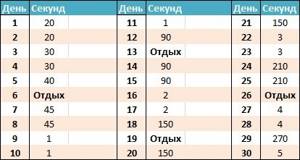
Addition
Another universal exercise: “Chair”.
Also use the tags “health”, “body” and “bodily practices”.
The plank significantly improves posture
But having a straight posture is so important!
It keeps your bones and joints in the correct position, resulting in them being better maintained by the body and becoming healthier.
The overall efficiency of your musculoskeletal system will increase.
You will forget about back pain.
And in general, a person with good posture looks healthier, more attractive and confident.
5. You will improve your overall health
Do you notice that sometimes you can't stand straight on one leg for more than a few seconds? No, you are not drunk - your abdominal muscles are just so weak that they cannot provide you with the desired result. Plank will fix this (and much more too).
♥ ON THE TOPIC: Why goosebumps appear on the skin, why fingers wrinkle from water and other unusual facts about the human body.
Top 5 mistakes when doing Planks
If the gym has a large mirror and instructors who will tell you how to do the exercise correctly, then at home “Plank” for beginners can become a problem. There are 5 common mistakes:
- The most common is the deviation of the pelvis from an imaginary line. If the buttocks are raised up, then the woman or man is simply wasting time, and there will be no expected effect from the exercise. It’s worse when the pelvis goes down, in this position the load falls on the lower back and you can get an intervertebral hernia, so you need to stand extremely straight.
- Deviation of the head up or, conversely, down. An additional load is placed on the cervical spine, which is fraught with consequences for the intervertebral discs.
- Extension of the elbow joints beyond the shoulders. In this case, the harmful load falls on both the elbow and shoulder joints.
- Beginners, in their desire to quickly get results, often increase the time they spend doing the Plank and try to stand there for as long as possible. Even if you do the exercise correctly, overexertion will not do any good, the body is not ready yet. It is better to break the training into several approaches.
- Watch your breathing - it should be even and deep; holding or shallow breathing will only do harm.
A detailed analysis of 5 common mistakes.






